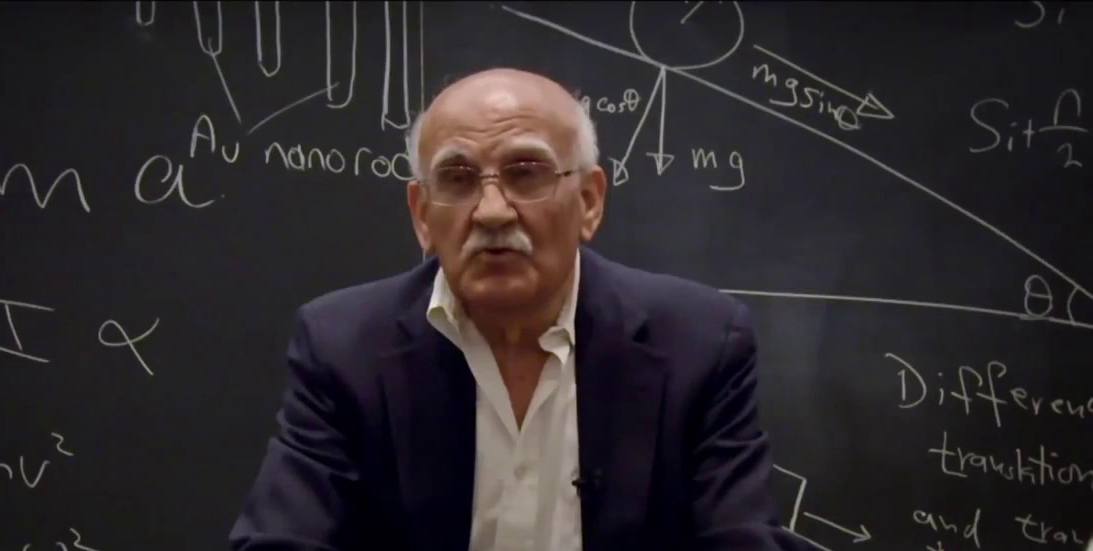Dr. Munir Nayfeh is a Palestinian-American particle physicist and tenured professor. Nayfeh has authored and/or edited over 130 papers and books on lasers, magnetism, and electricity. He has held several US-issued patents. Nayfeh’s research in nanotechnology has real world applications in diverse fields from solar power to health care.
The Islamic World Academy of Sciences elected Nayfeh fellow in 2009.
Researcher and Professor Munir Nayfeh
A 1974 Stanford graduate, Nayfeh began his career with a milestone paper on the Rydberg Constant. He collaborated with 2005 Nobel Prize winner Theodor Hansch.
That same year Nayfeh joined the US Department of Energy’s Oak Ridge National Laboratory for science and technology. He worked there as a research physicist for four years. In 1978 Nayfeh began as a lecturer at Yale University. Two years later, the scientist joined the University of Illinois as a Professor. He has remained there since. In 1985 he published the textbook Electricity and Magnetism for physics undergraduates.
In 2007 Nayfeh received attention for solar cell research he had done with the university. The scientist developed a way to improve solar cell performance by applying a coat of silicon nanoparticles.
“Integrating a high-quality film of silicon nanoparticles 1 nanometer in size directly onto silicon solar cells improves power performance by 60 percent in the ultraviolet range of the spectrum,” Nayfeh explained in a press release. Applied Physics Letters published the corresponding research paper, of which Nayfeh is co-author.
In addition to his work with the University of Illinois, Nayfeh travels back to Palestine to teach. He taught nanotechnology to high school students in Palestine using interactive lectures. The Palestine Academy for Science and Technology invited him along with other scientists to participate in their Science Communication and Outreach Program in 2019.
The professor gave a talk on practical applications of new nanotechnology research at Palestine’s Birzeit University in 2017. Nayfeh also lectures on the commercialization of innovations in nanotechnology to advance health care.
In 2005 Nayfeh founded NanoSi Advanced Technologies Inc. The company manufactured silicon particles to be used in electronics, solar energy, biomedical and other fields.
Munir Nayfeh’s award-winning family
Nayfeh was born in the West Bank in the village of Shweikeh in 1945. Due to Palestine-Israel conflict, his family later moved to Jordan where he completed high school. In 1968 Nayfeh earned his BA from the American University of Beirut. Two years later he completed his master’s in physics. A scholarship brought him to pursue his PhD at Stanford University in the US.
Dr. Munir Nayfeh’s older brother, Dr. Ali Hasan Nayfeh, is also a renowned scientist. He was the inaugural winner of the Thomas K. Caughey Dynamics Award. He is also a recipient of the Benjamin Franklin Medal for his contributions to Mechanical Engineering.
Ali Hasan holds a Stanford PhD in Aeronautics and Astronautics as well as several honorary doctorates from institutions internationally. The Virginia Polytechnic Institute appointed Ali University Distinguished Professor of Engineering in 1976.
Munir Nayfeh innovates in nanotechnology
Professor Nayfeh continues to research and experiment throughout his career. The scientist began a research program at the University of Illinois following his entry into their physics department. He studied the behavior of molecules in specific environments. Nayfeh’s ability to demonstrate unique processes has led to entirely new areas of research, including in molecular Coulomb explosions.
More recently, Nayfeh’s research at the university has followed two avenues into the study of atoms and electric fields. The first is an observation on the effect of strong dc electrical fields on hydrogen atoms. The second is an original technique using a scanning tunneling microscope and a laser.
Nayfeh is also using the scanning tunneling microscope to analyze the effects of hysteresis on the formation of solid matter. Doing this on the nanometer scale provides insights significant to technological innovation in nanoelectronics and photonics.
In 2018 Nayfeh published Fundamentals and Applications of Nano Silicon in Plasmonics and Fullerines: Current and Future Trends. This book delves into the possibilities of commercializing nanosilicon products.
The scientist also heads a project to help kids understand complex scientific concepts through the medium of stories.



